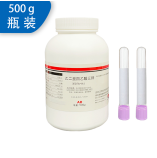- Category :
Other Chemicals
- CAS NO : 65501-24-8
- EC NO :
- Molecular Formula : C10H17K3N2O10
- Main Specifications : White Powder
- Synonyms : EDTA-3K��2H2O;Ethylenediaminetetraacetic acidtripotassium salt dihydrate;Ethylenediaminetetraacetic acid tripotassium salt dihydrate;tripotassium 2,2'-({2-[(carboxylatomethyl)(carboxymethyl)amino]ethyl}imino)diacetate dihydrate;EDTA tripotassium salt;EDTA-3K•2H2O;
Package: 500g/bottle
Uses : Blood collection additive
Molecular Structure:

Product description:
EDTA potassium, abbreviated as EDTA-K3, is often used as a chelating agent in various products, such as softeners, descaling agents, detoxifiers, etc., due to its chelating effect on metal ions. The most widely used field is in medicine, where it is added to blood collection vessels for pre-treatment of blood samples in clinical blood collection or testing, playing an in vitro anticoagulant role.
The anticoagulant properties of EDTA tripotassium can directly chelate metal ions in the blood during full contact after drawing a certain amount of blood, blocking coagulation function from the source. This way, the blood will not clump for a certain period of time, hindering the experimental process. Moreover, EDTA tripotassium does not damage blood cell components, has no effect on the number and size of white blood cells, and almost does not interfere with the morphology of red blood cells. It is very suitable for routine blood testing and its anticoagulant effect is considered one of the ideal anticoagulants.
The anticoagulant effect of EDTA tripotassium is non irreversible. To ensure the accuracy of the test results, it cannot be left on hold for a long time and is required to be completed within 24 hours. Additionally, it should be noted that the anticoagulant effect of EDTA tripotassium is not suitable for all blood test items. As an anticoagulant, it is not suitable for coagulation experiments. Additionally, due to its ability to chelate metals, it cannot be used in calcium ion, potassium ion, and other determination experiments.
 CN ChemNet > Gold Suppliers > Hubei new DE sheng material science and technology co., LTD. >
CN ChemNet > Gold Suppliers > Hubei new DE sheng material science and technology co., LTD. > 